

|
|
|
conf. | auteurs | abstract | key words | downloads | article |
| Conf. | |
|
Proceedings of the 8th Int. Coral Reef Symp. Panama, avril 1997 |
|
| Auteurs | |
| N.Conruyt, G.Faure, G.Ancel, J.Le Renard, M.Guillaume, O.Naïm, N.Gravier-Bonnet, D.Grosser | |
| Abstract | |
| A knowledge base is described which consists of computer aided systematics tools for describing, classifying and identifying coral specimens. An example is given involving 5 selected species of the genus Pocillopora from the Mascarene Archipelago (among more than 40 described species). The knowledge acquisition tools help the expert to build a descriptive model (what is observable), and to collect structured descriptions (observed cases) with a questionnaire. Then, the expert can apply the scientific method: experimenting (learning rules from cases with decision trees) and testing (identifying new observations with case-based reasoning). The method gives the expert the ability to update the knowledge base according to the results of determinations and comparisons, and thus improve iteratively his descriptive model and case base. The resulting expert system enables a user to identify the corals with a high probability of success. | |
| Key words | |
| knowledge base, Pocillopora, Mascarene archipelago, expert system, descriptive model | |
| Downloads | |
|
|
|
| Article : | |
ABSTRACT
A knowledge base is described which
consists of computer aided systematics tools for describing, classifying
and identifying coral specimens. An example is given involving
5 selected species of the genus Pocillopora from the Mascarene
Archipelago (among more than 40 described species). The knowledge
acquisition tools help the expert to build a descriptive model
(what is observable), and to collect structured descriptions (observed
cases) with a questionnaire. Then, the expert can apply the scientific
method: experimenting (learning rules from cases with decision
trees) and testing (identifying new observations with case-based
reasoning). The method gives the expert the ability to update
the knowledge base according to the results of determinations
and comparisons, and thus improve iteratively his descriptive
model and case base. The resulting expert system enables a user
to identify the corals with a high probability of success.
INTRODUCTION
Scientific databases are becoming
increasingly common in Biology. Some institutions distribute biological
databases on CD-ROM (e.g. ETI in Netherlands, ICLARM in the Philippines,
etc.) or make them available through the Internet (e.g. HBS in
Hawaii, AIMS and CSIRO in Australia, etc.). Specialists of a domain,
other biologists (students, amateurs) and professionals (environment,
tourism) can easily consult these information systems of taxonomic
and biogeographic significance.
In order to proceed, a lot of these
databases require the knowledge of the specific name of the specimen
under consultation. On the contrary, for a given taxon, knowledge
bases (or knowledge-based systems) provide those ignorant of that
name with some identification help, and they also give some classification
help (class definition) to the specialists whose domain has been
only partially studied so far (this is true for a great part of
the marine fauna).
The term knowledge base comes from
computer science and artificial intelligence. We prefer to use
it here instead of the term database because it is more accurate
for our purpose: knowledge is more general than data, i.e. we
rely not only on observed facts (data, descriptions, cases, examples),
but also on observable things (descriptive model, modelisation
of data, metadata) and produced facts (classification or decision
trees, rules, identification).
A lot of databases reproduce electronically
textual descriptions and identification keys that already exist
in books. This is of significant interest when it comes to a well-known
and stable field. But it is not sufficient as regards evolving
or not well-known groups. In such domains (sponges, hydroids,
corals, etc.), specialists are not particularly keen on disseminating
their taxonomic information. They need research-oriented systems
dedicated to systematics.
In other domains such as botany, some
researchers have come up with solutions for coding descriptions.
Their programs provide comparability of descriptions and bring
identification facilities to databases (e.g. Pankhurst 1970; Dallwitz
1974). The method of Dallwitz (1980) using DELTA (DEscription
Language for TAxonomy) was applied to the coral genus Acropora
by Wallace and Dallwitz (1981).
We use this kind of coding approach
in our study, but we have been more influenced by the machine
learning school in computer science (Quinlan 1986). The originality
of our work is to implement the scientific method in Biology:
experimenting (learning rules from examples) and testing (identifying
new observations, improving the initial model and descriptions).
Unlike the work of Brown and Navin
(1992) on scleractinian identification, we don't use traditional
elicitation of rules by interviewing the domain expert or taking
them from a monograph (like the one of Veron et al 1977). We start
from pre-classified descriptions (i.e with the associated identification)
that we call cases or examples. Then, we apply machine learning
techniques on them for extracting these rules by induction. The
input cases are compiled by the expert himself (here G. Faure).
Their information content comes from different sources: literature
(descriptions of the types of species, other monographs) and samples
from a collection (descriptions of specimens). Thus, with many
descriptions of the same class (or taxon) in extension, it is
easier to take into account intra-specific variations.
Our knowledge base aims at providing
computer aided systematics tools to experts for describing, classifying
and identifying coral specimens of the south-west Indian Ocean
(Mascarene Archipelago). As an outcome, the identification module
may be used by non specialists.
A first study has been conducted on
the genus Pocillopora, which includes 5 species (damicornis,
woodjonesi, eydouxi, verrucosa, meandrina)
among more than 40 species described at world level, and the 5
known ecomorphs of P. damicornis in the area (bulbosa,
acuta, brevicornis, caespitosa, favosa).
The reference collection is the one
of G. Faure (1982). It is located at the University of La Réunion
(Lab. of Marine Ecology), at the Museum of Natural History of
Saint-Denis de La Réunion and at the National Museum of
Natural History in Paris (Lab. of Biology of Marine Invertebrates
and Malacology).
METHODOLOGY
In order to apply the scientific method
in biology (conjecture and test), our approach follows a natural
process of knowledge acquisition which is divided in four steps:
Acquisition of a descriptive model,
Acquisition of examples (or cases),
Processing of this knowledge,
Validation.
Acquisition of a descriptive model
The descriptive model represents all
what is observable as a structured scheme, so that the user can
easily acquire the observed knowledge. Representation of individuals
(specimens and/or species) is different than a flat one in a data
matrix: in the former, there is a dependent composition of local
descriptions, although in the latter the defined characters are
independent one from each others.
In a descriptive model, there are
logical rules for describing a species (e.g. P. damicornis):
composition, point of view, specialisation, iteration, contextual
conditions, etc. (Le Renard and Conruyt 1994). The structuration
is a means to take into account good sense background knowledge
that can be useful for description capture, management and processing
(Allkin 1984).
All the observable components (called
objects or parts) of the species of Pocillopora and ecomorphs
of P. damicornis have been defined (Fig. 1). Their
own characters (attributes) have been listed. There are 37 objects
and 87 attributes for 9 descriptions (species and ecomorphs).
For example, the corallites on branch
ends have three attributes: shape, distribution and disposition.
For each attribute, the expert enumerates the observable values,
in order that all possible descriptions of the genus can be covered.
In some specimens, some objects can
be absent (e.g. on fig. 1, the object corallites on verrucae has
a minus sign before). Other objects like wall, septa, etc. are
dependent on the presence of the first: this background knowledge
must be explicitly represented in the descriptive model to ensure
the coherency of the description phase.
Some objects are physical (a box surrounds
them) and others are fictitious (no box): these latters indicate
viewpoints of the components at different levels of observation
(e.g. macro structure, micro structure).
In fact, one of the roles of the descriptive
model is to bring an observation guide for the end-user: the objects
are linked together with relations that go from the most general
to the most specific (from left to right), making the next description
process easier for the non specialist.
In Conruyt (1994), we show that the
acquisition of a descriptive model is the most important part
of the method: the robustness of classification and identification
results from the quality of processed descriptions, and thus from
a well designed descriptive model.
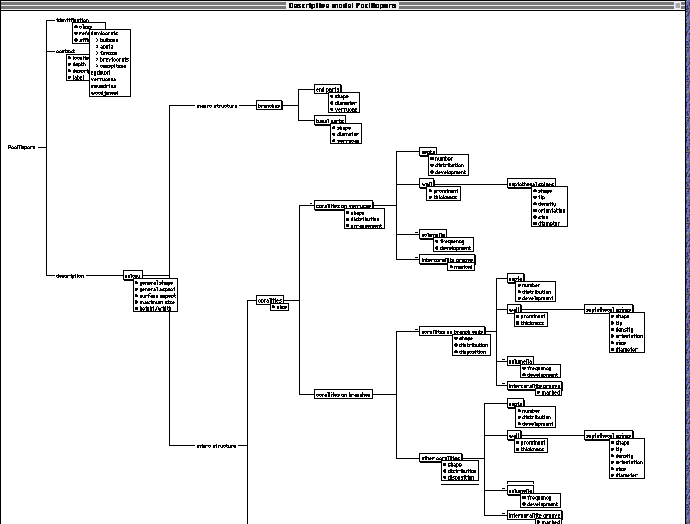

Fig. 1: the descriptive model of Pocillopora defines the structure of all observable descriptions of this genus in the Mascarene archipelago: 5 species and 5 ecomorphs of damicornis. The objects are the nodes of this description tree and the attributes are refered to each component. The figure shows here only the possible values of the attribute class of the object identification.
Acquisition of examples (or cases)
Starting from the definition of the
descriptive model, a program builds a questionnaire automatically.
It allows the expert and other biologists to acquire individual
descriptions and make a case base. An identification is associated
to each description in order to form a case.
The questionnaire follows the structure
of the descriptive model: there are as many cards as there are
objects and attributes. The observed descriptions are sub-trees
of the descriptive model (see Fig. 1 and Fig. 2). Therefore, they
can be directly compared with one another in making them pass
cards by cards: this is easier than viewing lists of attribute-value
pairs.
Each card is a local view of an object
(Fig. 3). The user can navigate between cards in following the
path of descendants and parents step by step. He can also jump
from the description of an object to another through the use of
the global view (Fig. 2).
Attribute cards are leaves of the
description tree. As for objects, comments and illustrations for
each of the values may be provided by the expert: it helps the
user to interpret correctly the asked question (Fig. 4).


Fig. 2:
A structured presentation of a description of Pocillopora damicornis
acuta. The expert made a synthesis of descriptions for this
ecomorph, based on specimens and literature (the attribute label
of the object context is then unknown and the depth is an interval).
Absent objects are crossed out (e.g. corallites on verrucae):
other absent objects are deduced automatically (septa, wall, etc.).
Most attributes are nominals and few are numericals. Some nominal
attributes are classified (e.g. general shape of the colony) in
order to specify some states, others are multi-valued (e.g. shape
of corallites on branch ends): the object describes in fact a
set of components that can share simultaneously different values.
This remark is also valid for numerical attributes: the size of
corallites can vary between 0.7 and 1 mm.
Processing of this knowledge
Depending on the goal to be achieved,
two different types of method are used in order to process the
case base: induction for classification, case based reasoning
(CBR) for identification.
For classification purpose, a decision
tree is built. Starting from descriptions (representation in extension)
of classes to learn, an inductive method based on entropy and
information gain measure (Shannon 1949; Quinlan 1986) gives a
characterisation of these classes (representation in intension)
with a set of rules. Each path from the root to a leave of the
decision tree is a classification rule (also called a diagnose
in biology). For Pocillopora, we obtain the following decision
tree which classifies the 9 descriptions of species and ecomorphs
(Fig. 5). This classification tree can be used in consultation
mode to determine a new observation. It is one of the most discriminant
decision trees: in only two questions, we are able to reach a
conclusion. Nevertheless, when the user does not know how to answer
to a question, the consultation of the decision tree is inadequate
(Manago et al 1993).
For identification purpose, a CBR
strategy is used (Bareiss 1989). Given a set of examples, it dynamically
extracts the most efficient criteria from the ordered list of
tests after each answer of the user (Fig. 6). The cases are selected
from this reply. If the answer is unknown, the second most discriminant
test is proposed to the user, and so on.
Even if this method of identification
is more resilient to this noise (unknown responses), it is not
as good when facing errors of description. This is due to the
monothetic approach of this strategy (Pankhurst 1991): it is based
on one and only one criterion at a given moment.
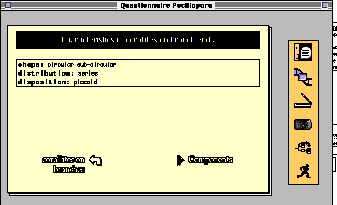

Fig. 3:
A local view of the object corallites on branch ends from
P. damicornis acuta. The characteristics of this object are
above and the components are below. The user can switch from one
local description to the other and navigate from this object to
other related objects.
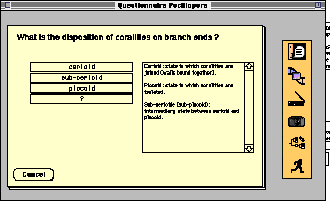
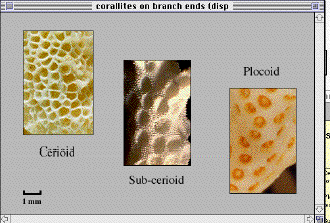
Fig. 4:
An example of a commented and illustrated attribute: disposition
of corallites on branch ends. The first icon on the top-right
opens a comment for the values and the icon of the camera opens
a window of illustrations (below).
Other methods of CBR are polythetic
(i.e. rely on a combination of criteria) and are more robust to
errors: the most similar cases method is derived from the k nearest
neighbours one in data analysis: the examples are retrieved in
calculating a similarity measure between descriptions. This is
a comparison process which implies the whole set of characters
(or attributes). A score between 0 and 1 gives the percentage
of resemblance between two cases (Fig. 7).
For the consultation, there is an
interest to combine these methods (induction and CBR) at different
levels of integration in order to get more robust results (Auriol
et al 1994). These knowledge processing tools are modules of the
KateTM software which is marketed by the company AcknoSoft
in Paris.
Validation
With the help of these tools, the
expert can evaluate the results of classification and identification,
according to the quality of its own descriptions and descriptive
model. Inductive learning as well as the repetitive use of the
questionnaire remain useful for detecting possible inconsistencies
within the case library, and thus for refining the knowledge base
(observable and observed facts).
This experimentation and test method is also a means for the computer scientist to improve algorithms in order to fit with user needs. For example, in the decision tree of Fig. 5, two very closed species (P. verrucosa and P. meandrina) cannot be discriminated. This can be interpreted by the expert as an interesting result from a classification viewpoint (authors don't agree really if they are the same or not).
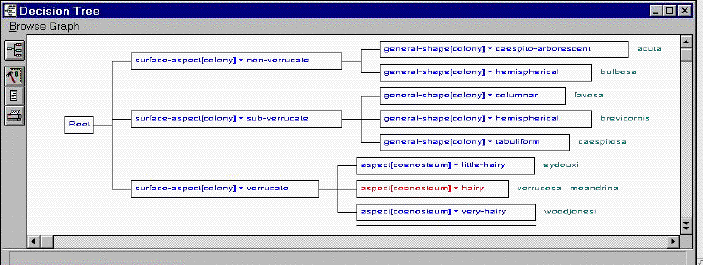
Fig. 5:
A decision tree for classifying the genus Pocillopora.
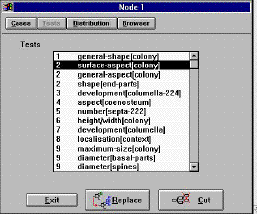
Fig. 6:
The list of ordered tests at a node (here the root node) is computed
with an inter-class discrimination measure: the information gain.
The higher is the gain, the more homogenous is the repartition
of cases between classes. At each node, the best test (i.e. the
most discriminatory attribute) is chosen to separate the cases
and generate a tree. Nevertheless, the user can modify the default
decision tree by replacing a test: the example of Fig. 5 was made
with the choice of the second most discriminant attribute at root
node.
But in fact, there exists some little
differences on multi-valued attributes between the two species
(e.g. distribution, number of septa). The presence of multiple
states was interpreted by the computer scientist as a disjunction
of values due to imprecision and not as a conjonction of values
due to intra-specific variation. So, an object representing a
set can share different states simultaneously (e.g. Fig. 2: shape
of corallites on branch ends: circular and subcircular). This
background knowledge must be differently processed: in case of
doubt, we have to refrain from discriminating whereas in case
of variation, the discrimination must carry on (i.e. finding other
criteria after the aspect hairy of coenosteum in Fig. 5).
Another requirement is to easily update
the case base after making modifications in the descriptive model.
The descriptive model supports all the validation process.
DISCUSSION
For the moment, only 9 descriptions
of species and ecomorphs have been recorded in the knowledge base,
corresponding to the 9 classes of Pocillopora. Those cases
were described by the expert. The descriptive model was refined
twice and now looks like the one of Fig. 1. Another work was to
illustrate each attribute from the questionnaire, like the one
of Fig. 4.
Now, we are able to take some specimens
in collection and tell other “naive” persons (like the
co-authors) to describe them through the questionnaire. We want
to integrate two other dimensions in the case base: the observed
intraspecific variability and the different interpretations of
vocabulary and illustrations on the same sample from many users.

Fig. 7:
The CBR strategy of the nearest cases makes identification of
classes (i.e. species and ecomorphs) by comparing the whole set
of characters of descriptions. A similarity measure counts the
associations of states for each character and delivers a resemblance
score between descriptions. We can see here that P. verrucosa
is near from the query P. meandrina: other classes have
a lower score.
Effectively, because of its very large
geographical and ecological distribution, this genus shows a great
intraspecific, even intracolonial variability (Veron and Pichon
1976).
This is why in the descriptive model
we have integrated the different sort of corallites within a species
and/or a colony: corallites on verrucae, corallites on branch
ends, other corallites (Fig. 1). Each of these objects shares
the same sub-tree or descriptive structure but with different
possible values.
Because of this variability, the species
present a very complex taxonomy which is often contradictory in
the literature. Some very significant characters of species for
an author are not recognized, or even in contradiction for other
authors.
For example, the development of columella
is today a character that discriminates the group P. verrucosa
- P. meandrina (absent or abortive) from the group P. eydouxi
- P. woodjonesi (well developped). But in the original description
of P. eydouxi (Edwards and Haime 1860), the columella is
absent. Furthermore, the presence of columella is not a specific
character of two species placed in synonymy with P. eydouxi
(P. grandis and P. elongata) as it is described
by Dana (1848): “columella obsolescent” (P. grandis),
“a minute columella sometimes seen” (P. elongata).
At last, the two first authors (Edwards and Haime 1860) point
out the presence of a “saillie columellaire bien développée”
in P. verrucosa.
Given such relative observations,
the expert must define a description structure of all observable
objects (past and present) in order to be exhaustive. This is
the most difficult task, but the descriptive model is the key
entry for communicating descriptions (preferably of specimens)
between specialists and other biologists. The descriptions will
be comparable on the same rigorous basis.
Thus, starting from the same descriptive
model and the descriptions of multiple specimens from a species
by different observers (specialists and apprentices), this will
allow us to give more robustness to learnt classification rules
and to resulting identifications.
CONCLUSION
After applying this methodology, every
one concerned with corals of the genus Pocillopora can
have the use of a robust expert system, and can thus identify
them with a high probability of success.
In future, we will apply the proposed
method to the identification of all coral genera of the Mascarene
archipelago (about 55 genera). We also plan to make a cooperation
with AIMS (Australian Institute of Marine Science) to build an
identification system of indo-pacific corals (about 70 genera)
that will be added to their CoralBase project.
ACKNOWLEDGMENTS
We want to thank P. Gigord, Director
of IREMIA, for finding funds that allowed us to build our prototype
on Pocillopora. We also thank D. Choussy for taking the
photos that illustrate the application, and W. Birnie for english
improvement. We are also grateful to J. McManus who critically
revised the linguistic content of the manuscript.
REFERENCES
Allkin R (1984) Handling taxonomic
descriptions by computer. In; Allkin R and Bisby FA (eds.), Databases
in systematics. Systematics Association London, Academic Press,
(26) pp 263-278
Auriol E, Manago M, Althoff KD, Wess
S, Dittrich S (1994) Integrating induction and case-based reasoning:
methodological approach and first evaluations. EWCBR-94 - Second
European workshop on case-based reasoning. M Keane, JP Haton &
M Manago (Eds.), AcknoSoft Press, pp 145-155
Bareiss R (1989) Exemplar-based knowledge
acquisition: a unified approach to concept representation, classi-fication
and learning, London, Academic Press inc
Brown D, Navin K (1992) An interactive
knowledge base for identification of scleractinian corals. Proc
7th
Int Coral Reef Symp Guam 2 : 661-664
Conruyt N (1994) Amélioration
de la robustesse des systèmes d'aide à la description,
à la classification et à la détermination
des objets biologiques. Thèse de doctorat, Univ Paris-IX
Dauphine, pp 1-281
Dallwitz MJ (1974) A flexible computer
program for gene-rating identification keys. Syst Zool 23 : 50-7
Dallwitz MJ (1980) A general system
for coding taxonomic descriptions. Taxon 29 (1) : 41-46
Dana JD (1846-1849) Zoophytes. U.S. Exploring
Exped, 1838-1842, (7) pp 1-740
Edwards H Milne, Haime J (1857-1860) Histoire
naturelle des Coralliaires, Paris (3) (1860) pp 1-219
Faure G (1982) Recherche sur les peuplements
de sclé-ractiniaires des récifs coralliens des Mascareignes.
Thèse es sciences, Univ Aix-Marseille II, (2) pp 1-206
Le Renard J, Conruyt N (1994) On the
representation of observational data used for classification and
identification of natural objects, IFCS'93, Lecture Notes in Artificial
Intelligence, Springer Verlag, pp 308-315
Manago M, Althoff KD, Auriol E, Traphöner
R, Wess S, Conruyt N, Maurer F (1993) Induction and reasoning
from cases. First European workshop on case-based reasoning (EWCBR-93),
MM Richter, S Wess, KD Althoff and F Maurer (Eds.), Springer Verlag,
(2)
Pankhurst RJ (1970) A computer program for
generating diagnostic keys. Computer J. 13 : 145-151
Pankhurst RJ (1991) Practical taxonomic
computing. Cambridge University Press, Cambridge, pp 1-202
Quinlan JR (1986) Induction of decision
trees. Machine Learning 1 : 81-106
Shannon CE (1949) The mathematical
theory of communi-cation. University of Illinois Press, Urbana
Veron JEN, Pichon M, Wijsman-Best
M (1976-1984) Scleractinia of eastern australia, vol. I to V,
Australian Institute of Marine Science Monograph Series
Veron JEN, Pichon M (1976) Scleractinia
of eastern australia, vol. I, Part I, Australian Institute of
Marine Science Monograph Series
Wallace CC, Dallwitz MJ (1981) Writing
coral identifica-tion keys that work. Proc 4th
Int Coral Reef Symp Manila 2 :187-190
[ Page d' Accueil | Publications | Bienvenue | Top ]
© IREMIA - Equipe IKBS - 03/1999